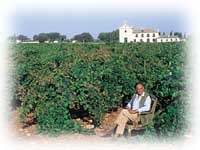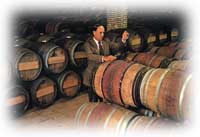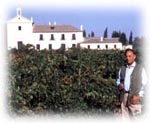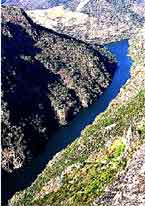History:
Carlos Falcó y Fernández de Córdova, Marquis of Griñón, has been one of the pioneers in modernising the vine growing and wine-making business in Spain. He graduated in Agronomist Engineering at the University of Lovaine (Belgium), and also later at the Davis University (California).
 In
1974 he introduced the Cabernet Sauvignon and Merlot grape varieties into
Spain, and then, Chardonnay, Petit Verdot and Syrah. The first two wines,
handled under the management of Professor Emile Peynaud of Bordeaux, were
the "Marqués
de Griñón" Rueda Superior 1982 white wine, presented on
the Spanish market in the Spring of 1983, followed by the "Marqués
de Griñón" Cabernet Sauvignon 1982 red wine, presented in London
in 1986.
In
1974 he introduced the Cabernet Sauvignon and Merlot grape varieties into
Spain, and then, Chardonnay, Petit Verdot and Syrah. The first two wines,
handled under the management of Professor Emile Peynaud of Bordeaux, were
the "Marqués
de Griñón" Rueda Superior 1982 white wine, presented on
the Spanish market in the Spring of 1983, followed by the "Marqués
de Griñón" Cabernet Sauvignon 1982 red wine, presented in London
in 1986.
In 1989 the construction of a new underground air-conditioned wine cellar began at the property "Valdepusa" with a fermentation capacity of 2000 hl., a building for ageing in cask (capacity 2,000 casks) and another for ageing in bottles (capacity 600,000 bottles) at his property in Malpica.
Between 1989 and 1990 he started the production of two new wines, resulting from in-depth research in the River Duero Valley:
- Marqués de Griñón Rueda Superior Crianza, white wine fermented and aged in new French oak casks.
- Marqués de Griñón Durius, a Crianza (third year wine) based on Tinto Fino and Tinta de Toro grapes.
In February 1994, after three years of research and production in collaboration with Bodegas Berberana at their wine cellar in Ollauri (La Rioja) ¨, a joint venture agreement was signed to produce fine red wine at La Rioja.
In
March 2000, the Marqués de Griñon discovers the last Spanish part of the
Valle del Duero, the Upper Duero region and acquires 30h wine estate where
a modern wine cellar will be constructed: Bodegas Durius.
Dominio de Valdepusa (Montes de Toledo):
The
vineyards and wine cellars of Malpica are located on the Valdepusa estate
(property of the family since 1270), at Malpica de Tajo, in the South
of Spain and 50 kilometres from Toledo within the Dominio de Valdepusa.
La Bodega de Malpica
 Located
in a historic 18th century building, it is fitted with the very lastest
technology. Its underground caverns, completely renewed in 1989, have
a modern installation with air conditioning and humidity control that
allows wine making and ageing at controlled temperature. The other wine
cellar facilities are completed with:
Located
in a historic 18th century building, it is fitted with the very lastest
technology. Its underground caverns, completely renewed in 1989, have
a modern installation with air conditioning and humidity control that
allows wine making and ageing at controlled temperature. The other wine
cellar facilities are completed with:
- A bottling plant for 2,500 bottles/hour.
- 850 French oak casks
- 17 stainless steel tanks with temperature control for the fermentation process, with a storage capacity for 500,000 litres.
- 5 ton pneumatic press
- Straining of wine.
- Cask building with air conditioning to allow temperature and humidity control.
- Modern warehouses of 2,000 m² for raw material and finished product, that allow an efficient logistic service.
The Vineyards
Located in Malpica de Tajo, 50 km. from Toledo, this was the first vineyard in Spain where the mixed plantation system was applied. This technique allows the use of the most advanced technology, the "canopy management".
 Within
the historic domain of Valdepusa, the vineyards occupy an area of 50 hectares,
30 of which are today planted with Cabernet Sauvignon, Chardonnay, Petit
Verdot and Syrah, using a mixed system.
Within
the historic domain of Valdepusa, the vineyards occupy an area of 50 hectares,
30 of which are today planted with Cabernet Sauvignon, Chardonnay, Petit
Verdot and Syrah, using a mixed system.
Dominio
de Susar (La Rioja)
 The
Dominio de Susar has more than 400 barrels of French and and American
oak in which the wines mature. The indigenous Tempranillo co-exists with
the experimental Syrah, Cabernet Sauvignon and Merlot in their vineyards
which occupy more than 20 hectares. In the Dominio de Susar vineyards,
drip method irrigation and canopy management systems are used. These systems
have already proved highly successful in the Dominio de Valdepusa.
The
Dominio de Susar has more than 400 barrels of French and and American
oak in which the wines mature. The indigenous Tempranillo co-exists with
the experimental Syrah, Cabernet Sauvignon and Merlot in their vineyards
which occupy more than 20 hectares. In the Dominio de Susar vineyards,
drip method irrigation and canopy management systems are used. These systems
have already proved highly successful in the Dominio de Valdepusa.
Bodegas
Durius (Alto Duero)
The
Durius wine cellars are located in the Arribes  del
Duero; 140 kms of valleys with a special microclimate which, together
with soil quality, makes it an ideal area for vine cultivation. We have
31 hectares on the estate where we apply the latest technology to produce
quality grapes, drip irrigation, trellises for canopy mana-gement, automatic
fertilisation etc.
del
Duero; 140 kms of valleys with a special microclimate which, together
with soil quality, makes it an ideal area for vine cultivation. We have
31 hectares on the estate where we apply the latest technology to produce
quality grapes, drip irrigation, trellises for canopy mana-gement, automatic
fertilisation etc.